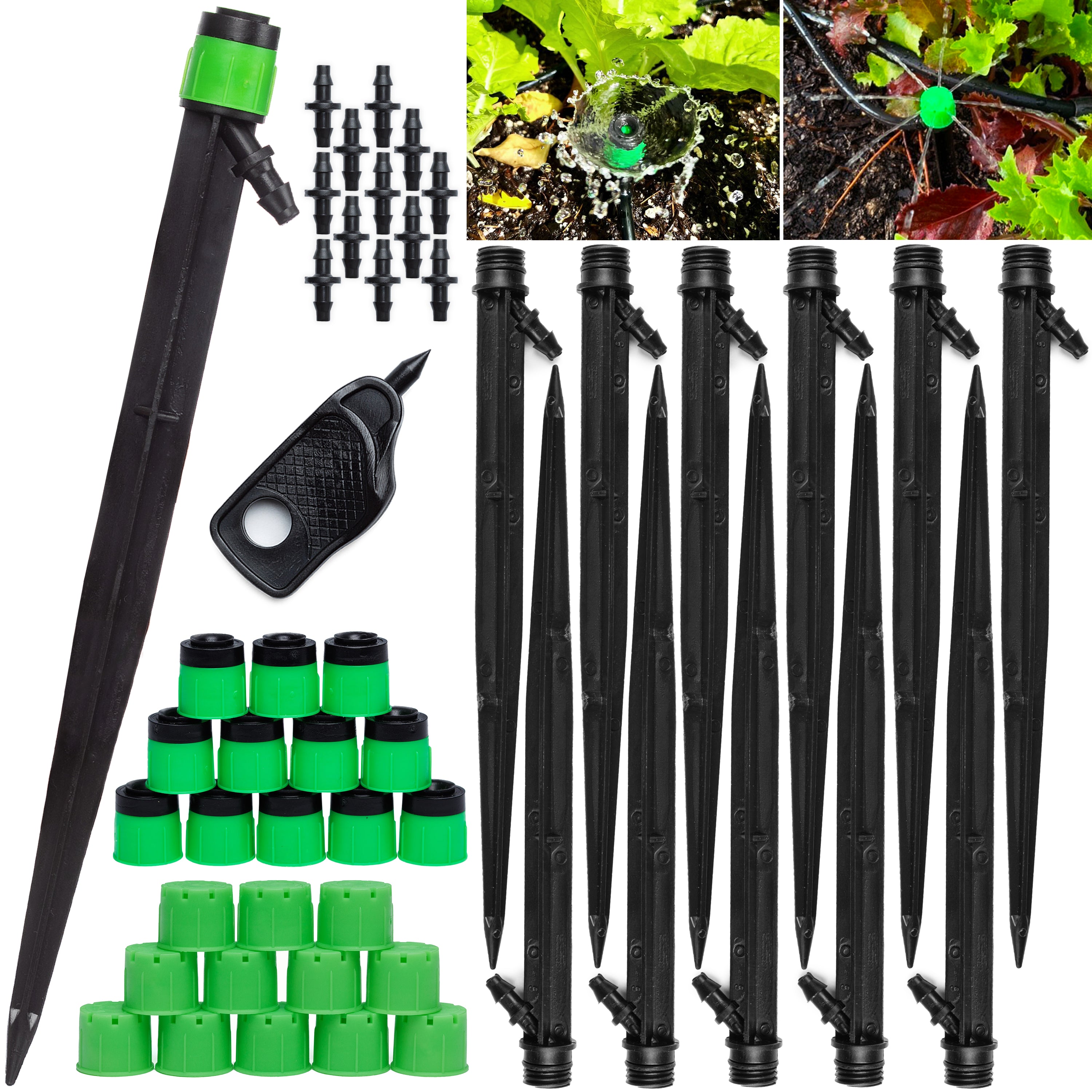
What's in the box?
- 12 x Drip Emitters for 1/4 drip irrigation tubing
- 12 x Vortex Caps (Preinstalled)
- 12 x Stream Caps
- 12 x 1/4" Barbed Couplings
- 1 x 1/4" Mini Hole Puncher
- A gift from our team: 1 Printable Gardening Handbook
Check our Installation Video for the Carpathen
Drip Irrigation Emitters Mix-it-Up
Installation Steps
The emitters are designed to work with a pressure of between 15 and 45 PSI. Maximum water volume delivered by a single emitter:
360 Stream
- 60 Gallons/hour at 45 PSI
- 55 Gallons/hour at 35 PSI
- 45 Gallons/hour at 20 PSI
Vortex
- 45 Gallons/hour at 45 PSI
- 35 Gallons/hour at 35 PSI
- 30 Gallons/hour at 20 PSI
Please take into consideration that the water pressure in the circuit drops with every new emitter installed.
First, please make sure you have some form of filtration and pressure regulation installed on your water source.
Why is it important:
Filtration: the couplings and emitters have small openings that can clog with debris or sediments if there’s no filtration used.
Pressure regulation: pressure over 45 PSI can blow off the fittings and damage the micro irrigation system over time. You can find a wide variety of inexpensive pressure regulators on Amazon.com or at your local home improvement store.
Second, you’ll need distribution tubing to get the water to the area needed.
1/2" distribution tube as a mainline from your water source throughout your needed area
1/4" distribution tube for connecting the emitters to the mainline (like Carpathen 1/4" Distribution Tube available in 60 and 120 feet coils).
Do not use oil or other lubricants to assemble the parts; it will deteriorate the line and fittings and make them easier to blow off under the water pressure.
Do not use glue as it might clog the installation and you won’t be able to clean it in case of debris or sediments.
Step 2 - Attaching 1/4" Barbed Coupling (B)
Attach one 1/4" Barbed Coupling (B) by pushing it firmly into the hole until it clicks (please make sure that the tubing is cool to touch at this step).
Step 3 - Running the needed length
Run the needed length of 1/4" distribution tube from the mainline to your plant (try not use more than 5 feet of tubing per branch).
Step 4 - Connecting the 1/4” tube
Connect one end of the 1/4" tube to the barbed coupling and the other to an emitter. Make sure the tube covers the barb entirely so it won’t come out when you turn on the water.
Obs: The barbs are designed to be slightly larger than the 1/4" tubing to prevent it from sliding back off. If you find it too difficult to push the tube all the way through, soften the tube end by slightly heating it with a heat gun or soak it in hot water. The tubing will slide on very easily and contract over the barb when cools down, sealing the connection.
Step 5 - Inserting the emitters
Insert the Emitter’s stake in the ground. Please do not use excessive force - if the ground is too hardened, water it a bit to soften before inserting the stake.
Step 6 - Open the water source to flush out any debris
With the end of the 1/2" mainline tubing open, flush out any debris or dirt that may have gotten into the line during installation. Continue flushing until water runs clear.
Step 7 - Closing the mainline
Close/plug the mainline tubing and open the water.
Step 8 - Inspect circuit
Inspect the entire circuit and make sure there are no leaks or tube kinks.
Step 9 - Inspecting the emitters and adjusting the water flow
Inspect each emitter and adjust the water flow to desired level by screwing/unscrewing the green cap. It can be adjusted from barely dripping near the stake up to a maximum of 50-60 Gallons/hour with a radius of over 3-4 feet, depending on the water pressure in the system.
Frequently Asked Quaestion Drip Irrigation Emitters
No water flow is coming out of the sprinkler's head.
First, with the water turned on take out the adjustable cap and make sure that water runs clear from the barb. Secondly, check and clean if needed the adjustable cap of calcium and lime deposits or debris. Finally, reconnect the cap, turn on the water supply, and screw/unscrew the cap to the desired water output.
Leaking around the emitter’s cap.
This usually happens if the emitter cap is not screwed on enough. To fix it, screw the cap a little more. If this does not work, remove and screw the cap again, correctly, to fix the problem.
The 1/4" tubing is being blown off the couplings or the emitters.
This could be caused by the tubing not being fully pushed over the barb or excessive pressure. Reconnect the tube, making sure it covers well the entire barb, and check the pressure. The system should not have an operating pressure higher than 40 PSI. Additionally, you can try cutting the small section of the tube where the barb was initially connected and reconnect.
How can I help protect emitter heads from being damaged by small animals?
Squirrels and other rodents chew on the emitter trying to get access to the water. Providing them with other sources of water, easily accessible, can deter them from chewing up your emitters. Try filling small containers with water and scatter them around your area. If this solution does not help, you can use wire screen mesh to restrict their access to the emitters.
Maintenance
Once or twice a year, remove the emitter caps and flush the circuit until the water runs clear. If you see a build-up of calcium or lime deposits, soak them in vinegar to clear them off.
If you live in an area that has freezing temperatures and/or hard frosts, it will be necessary to completely drain your drip system to prevent the lines and other parts that contain water from being damaged. Please thoroughly double-check the 1/4" tubing as kirks can prevent water from draining.

